Kicker Rock – San Cristobal by Boat
In the last post on this Adventures Abroad Experiental tour of Ecuador we landed on the Galapagos island of San Cristobal and immediately were immersed in the amazing wildlife for which the archipelago is so famous. In this post we’ll board a small boat and continue to look for more unique species on land and sea with a special stop to snorkel at legendary Kicker Rock. Please join us.
The breakfast room at the Galapagos Sunset Hotel in the San Cristobal overlooks the harbour and we enjoy a nice breakfast looking down at the boats we will soon be boarding for our excursion today. The weather is warm and sunny, but not super hot as the cold Humboldt Current has a moderating effect not only on the water temperature, but the air as well. But don’t get me wrong, it’s still t-shirt and shorts weather although we will need to don the wet suits we picked up the day before for the snorkelling.
Our tour guide Alfredo Meneses and local guide Jairo divide us into two groups of eight and we walk the short distance to the dock from where each group is ferried to a larger boat via a small zodiac. This is the boat Alison and I will share with six other tour members as well as Alfredo and the captain and crew. It’s more than spacious for this small group.
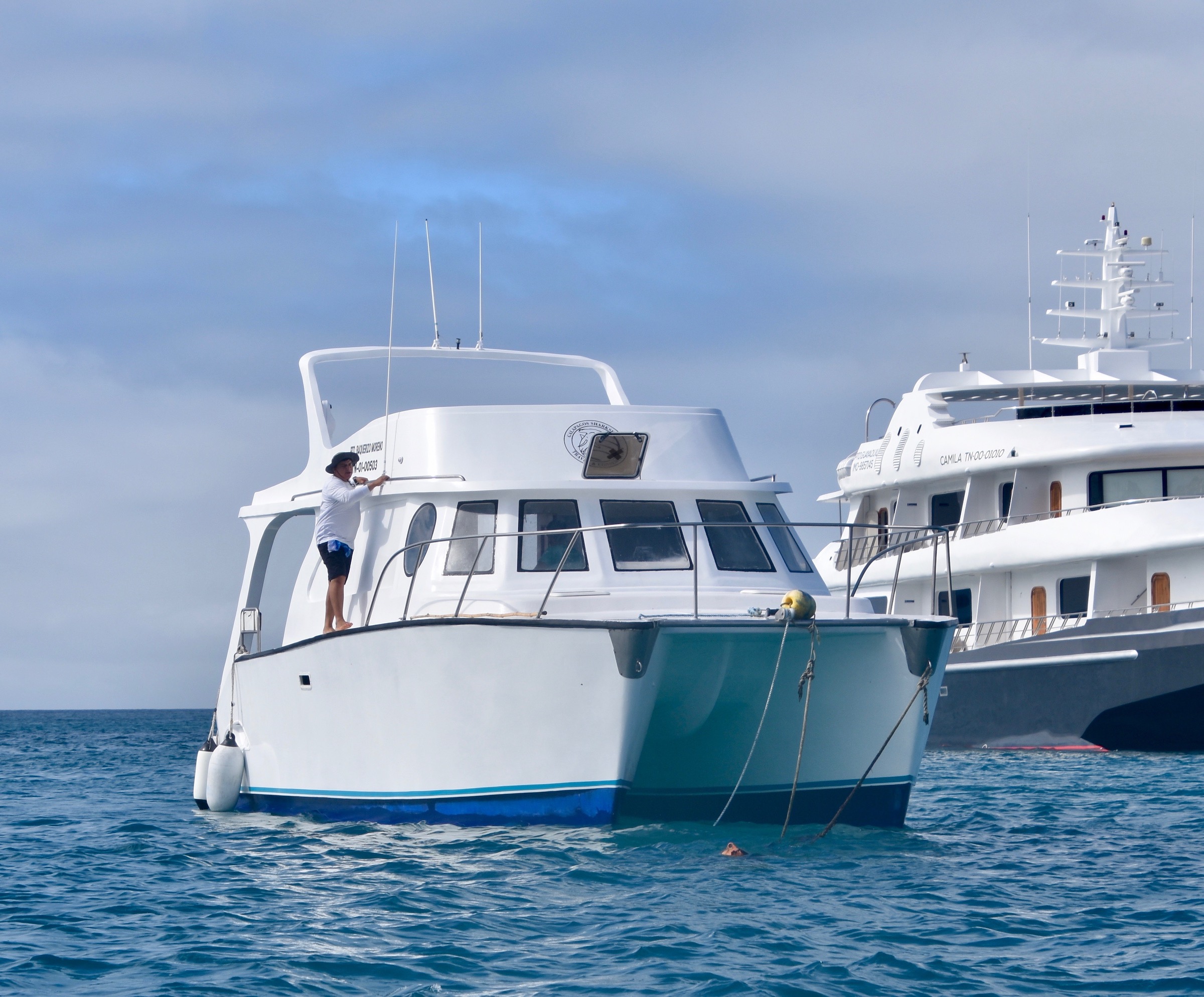
I should note that the itinerary for this day states that the excursion will visit either Kicker Rock, Cerro Brujo or Punta Pitt depending on the national park regulations of the day. As I noted in the first post, the number of visitors to the most popular sites in the Galapagos are strictly regulated by both numbers and times. However, with the great decrease in the number of cruise ship passengers, we were able to visit both Kicker Rock and the Cerro Brujo area on this trip, but not Punta Pitt which is on the northernmost point of San Cristobal.
This is a map of San Cristobal. We will head north out of Wreck Bay on the southwest corner of the island and follow the coast to our first stop at Cerro Brujo Beach in Stephens Bay. After a stop there we will continue following the coast as far as around Cerro Brujo where we will get a view of Kicker Rock through Darwin’s Arch. Lastly we will head to Kicker Rock where we will circle the island before stopping to snorkel. The other boat will follow the same itinerary, but in the opposite order.
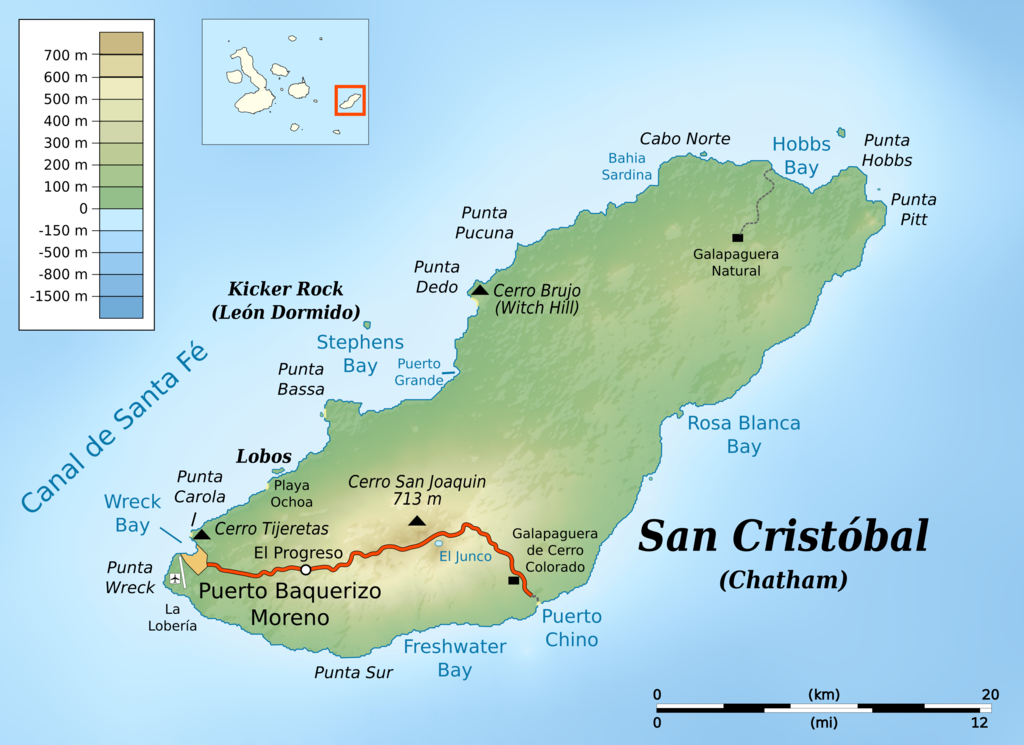
As well pulled anchor I took this photo looking back at Puerto Baquerizo Moreno. Our hotel is the white building in the middle. It looks more overcast than it actually was with much bluer skies to come.
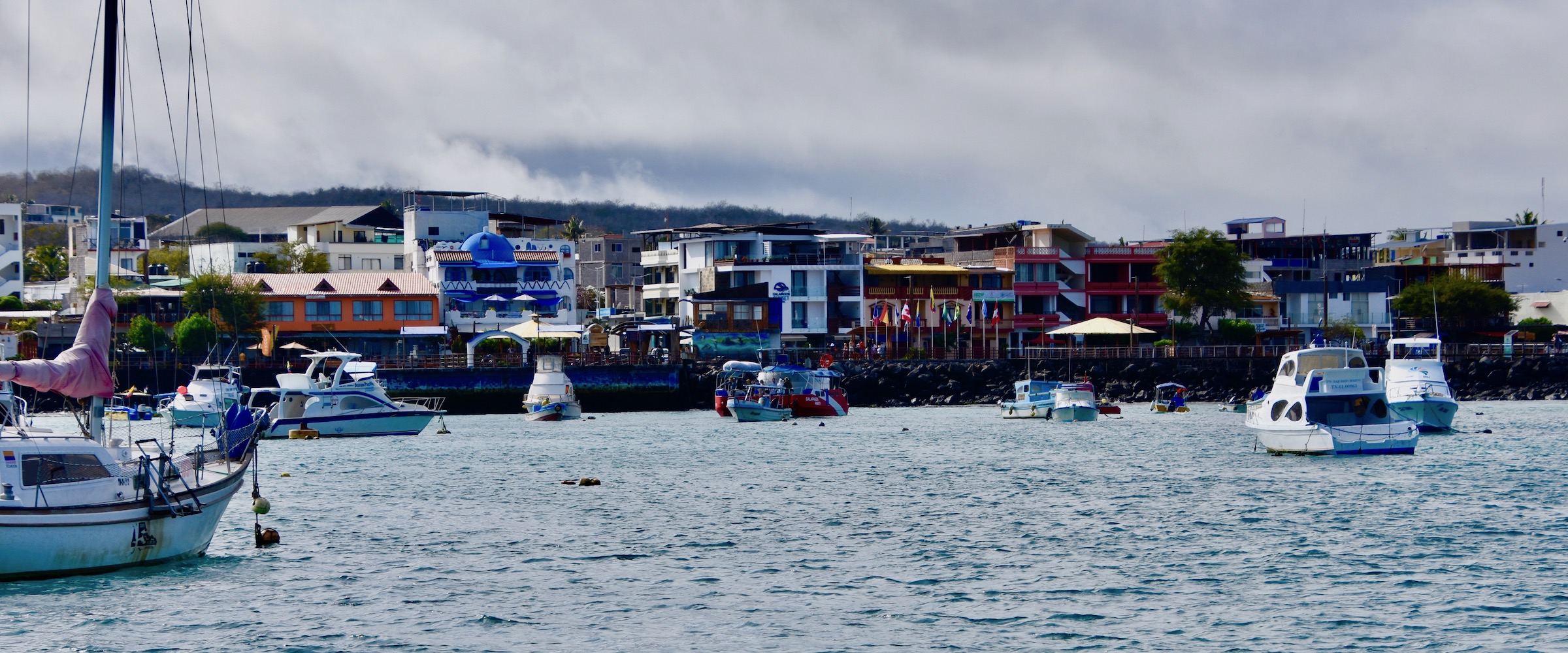
Playa Mann, which yesterday was crowded with both people and sea lions, is now bereft of the latter, but later in the day the sunbathers and swimmers will return.
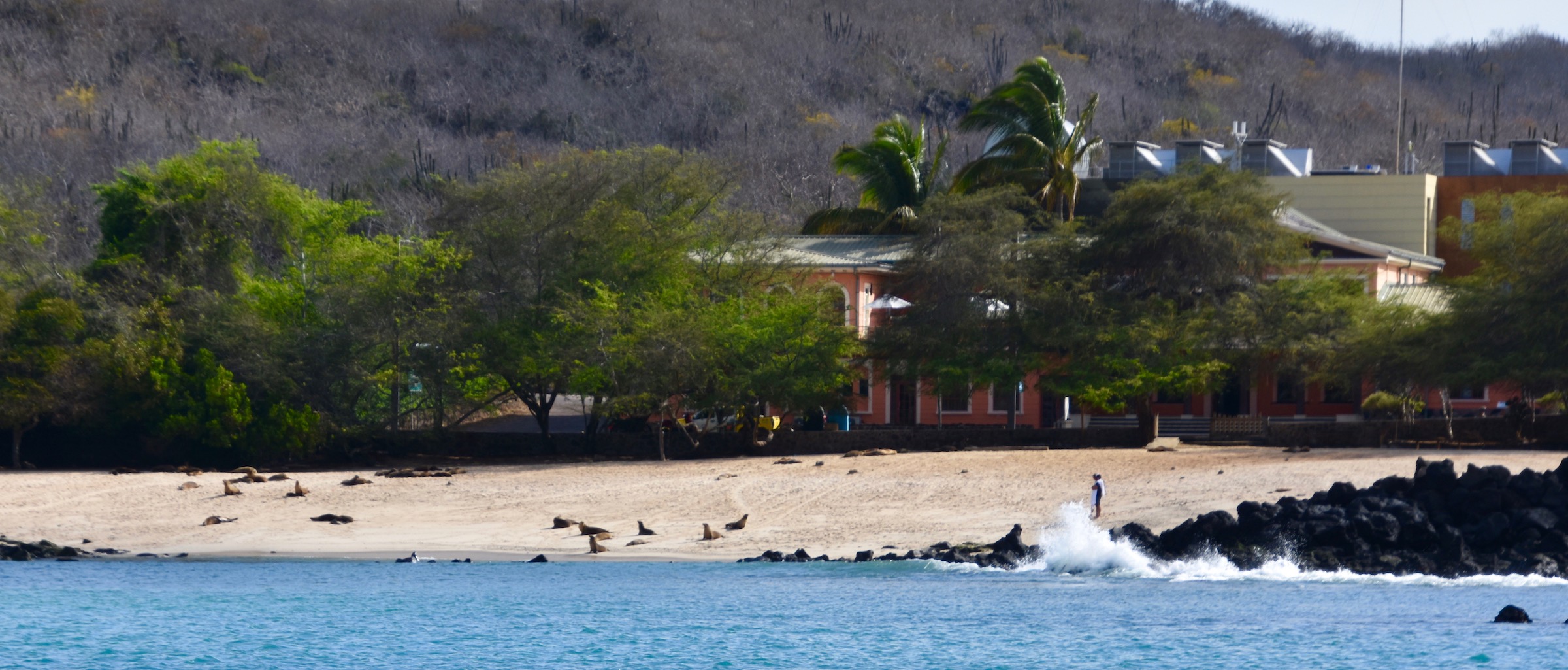
All the Adventures Abroad guides in my experience are very good naturalists and Alfredo is no exception as he keeps a wary eye out for anything interesting. I know it looks like he’s napping, but trust me, he’s not.
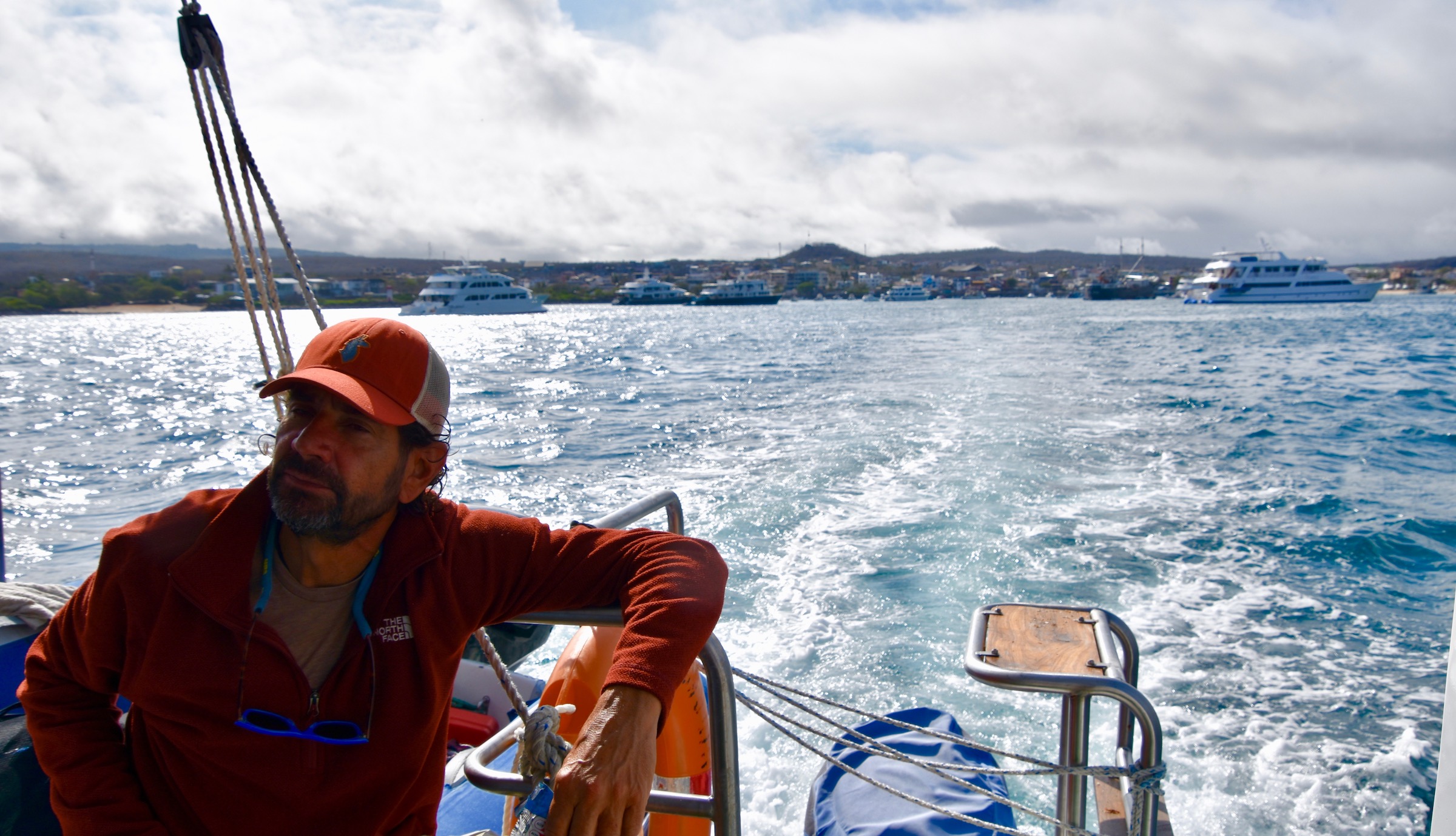
Alfredo proves he’s on the lookout as he orders the captain to stop and he points out two swallow-tailed gulls which is a much bigger deal than you might think at first glance. This species is only found on land in the Galapagos and one island off Colombia. They are only here to breed, otherwise they are totally pelagic. But here’s the real kicker – they are the only fully nocturnal gull in the world. They only feed at night and have the best adapted night vision of any seabird. Thus, seeing them out here in the daylight is really something. This is a life lister for every birder on the boat and bodes well for the rest of the trip. Good spotting Alfredo as this was the only time we saw this species on the trip.
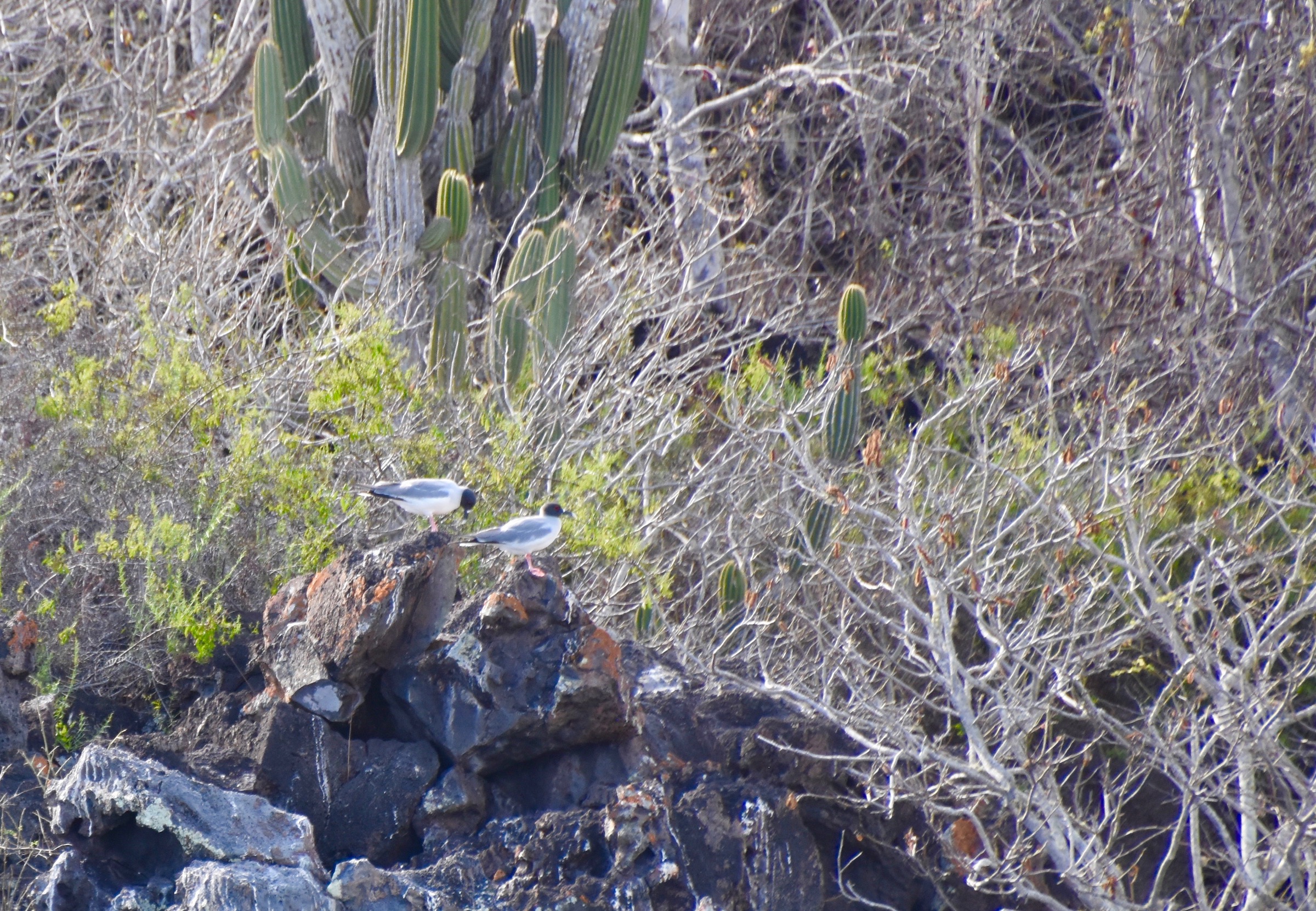
Moving on we passed this very nondescript looking hill, which actually was the spot from which Darwin did much of his observations on San Cristobal. It’s proper name is Cerro Tijeratas which translates to Frigate Bird Hill and in season both species of frigate bird breed here. If you look closely you can see an observation deck on the right hand side and you can walk here from the Interpretation Centre. Looking at the photos taken from this spot on Trip Advisor, I’m really sorry I didn’t take the time to make this reasonably short hike. Don’t make the same mistake when you visit.
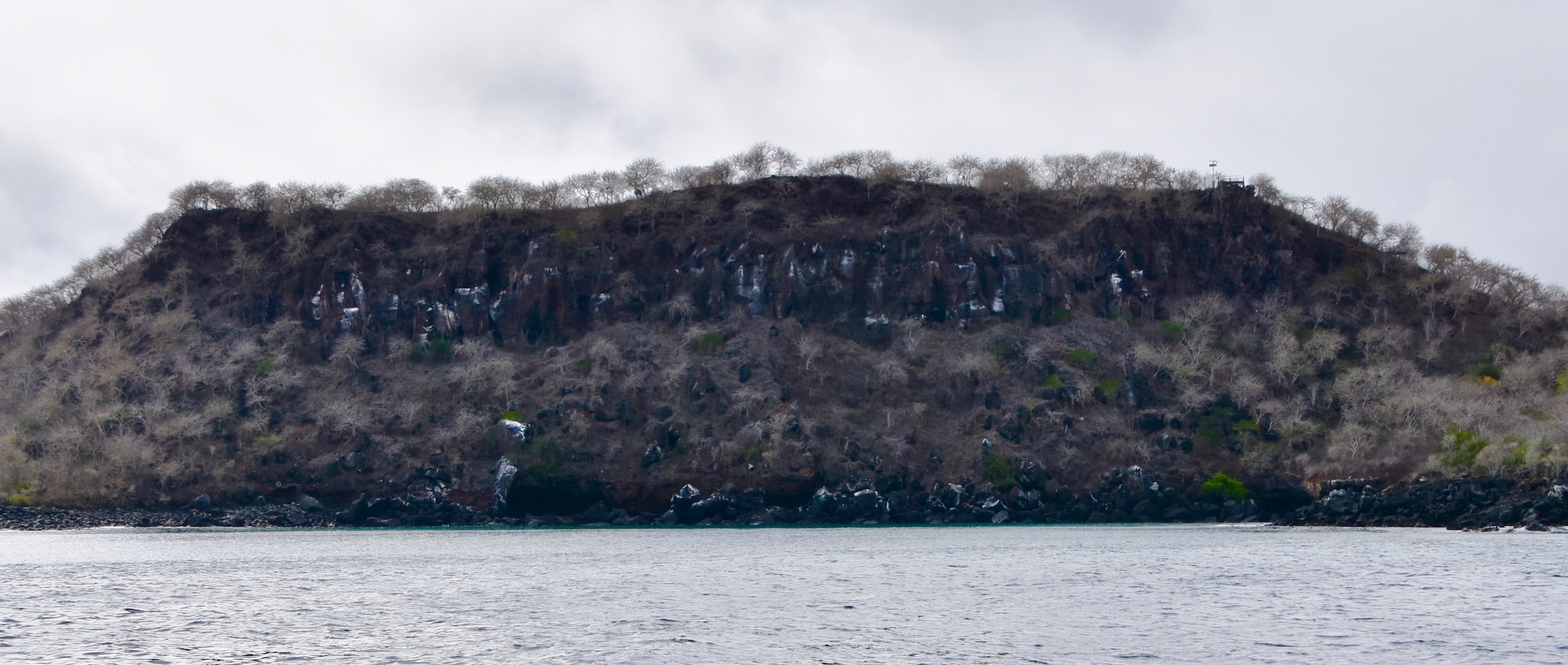
Off in the distance Kicker Rock and Cerra Brujo now came into view. While the other boat headed for Kicker Rock we peeled of to the right headed for one of the nicest beaches I’ve ever had to privilege to step foot on.
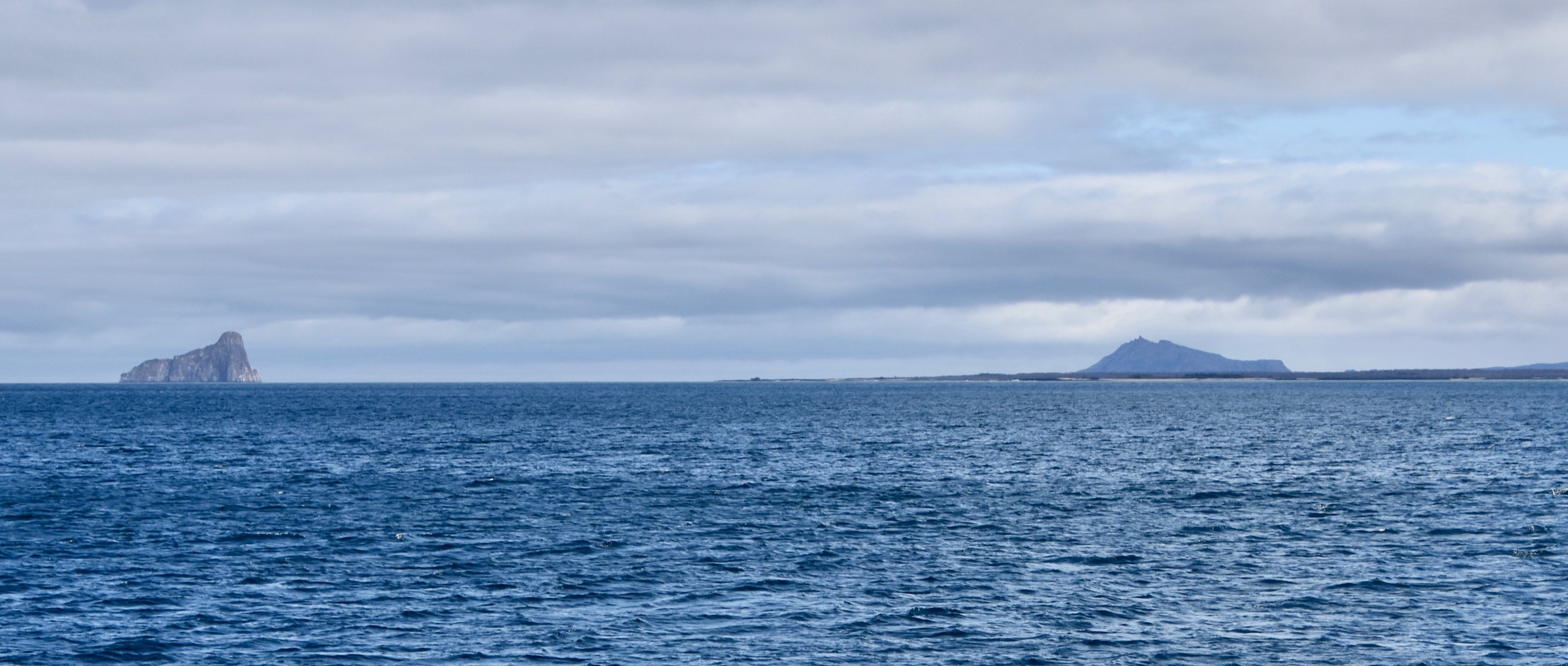
This is a closer look at Cerro Brujo or Witch’s Hill in English, a volcanic cone that starts at one end of the beach we are about to land on.
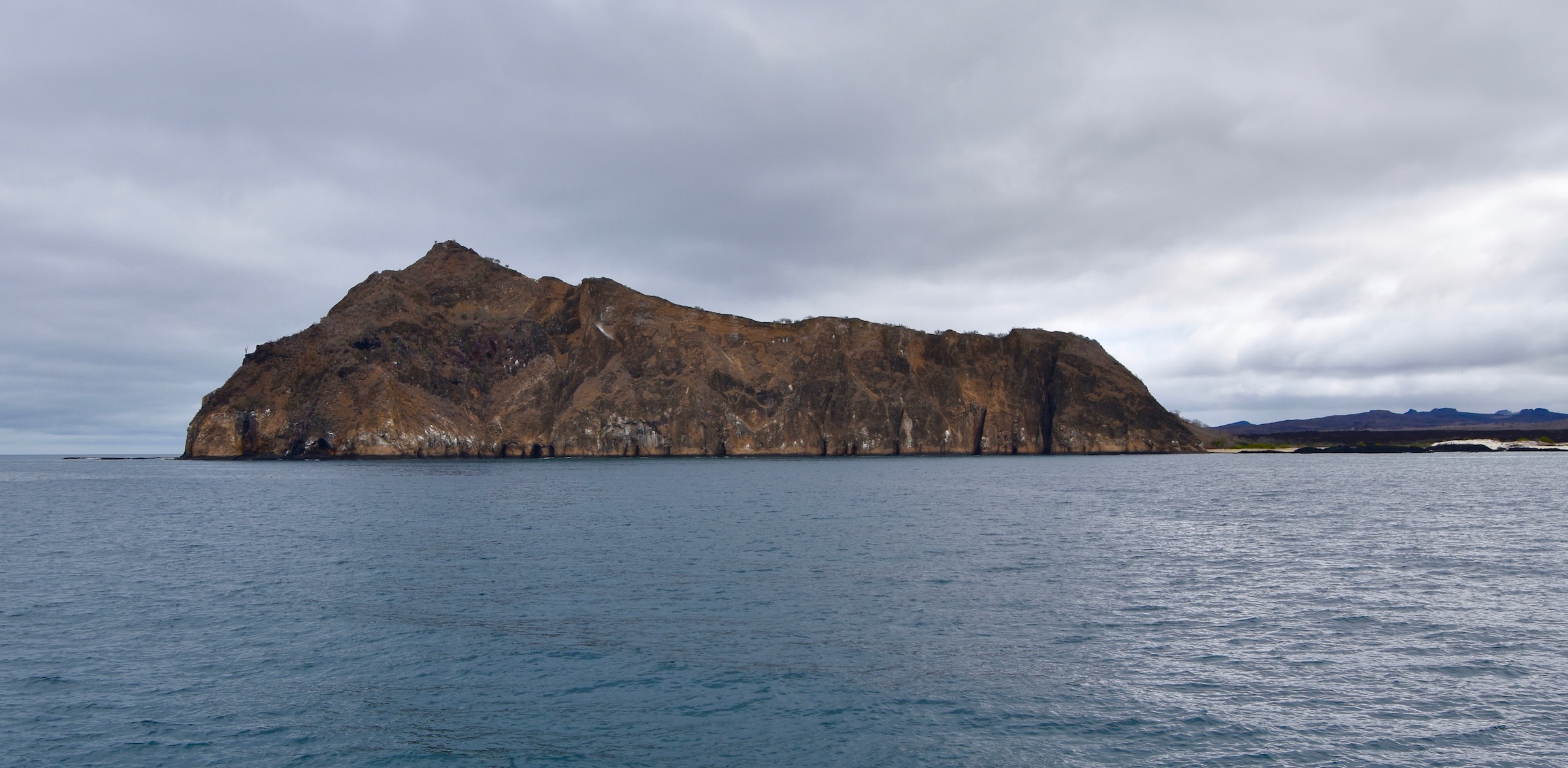
The landing takes place via a zodiac that cannot accommodate all of us on one trip and even though it looks calm, there are still decent waves breaking on the shore. Prepare to get soaked on this truly ‘wet’ landing, but also prepare to be amazed when to look around at your surroundings.
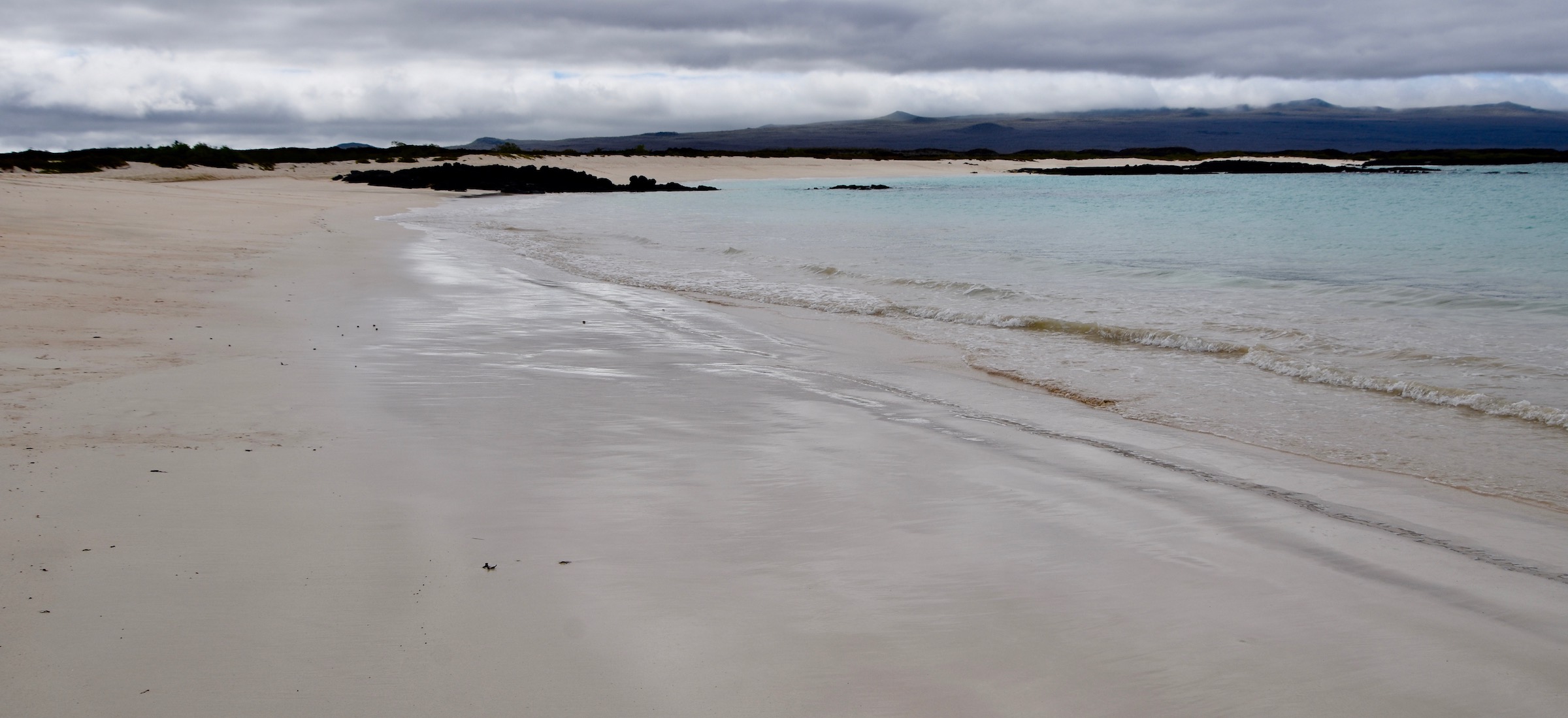
This is one of the nicest beaches I have ever set foot on and we are the only ones here. At least until the zodiac returns with the rest of the group. Note the curious sea lion watching the zodiac’s departure.
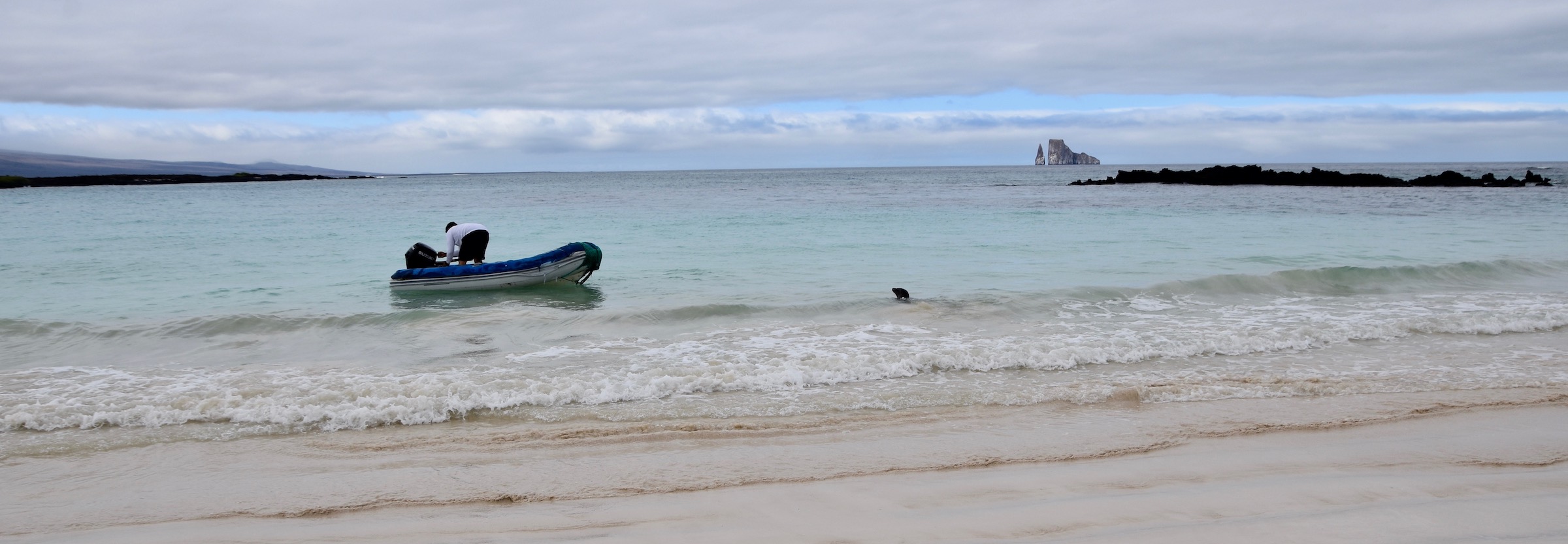
Ok, let’s explore, but first we’ll get Alfredo to take our picture to prove we actually got to this magical place.
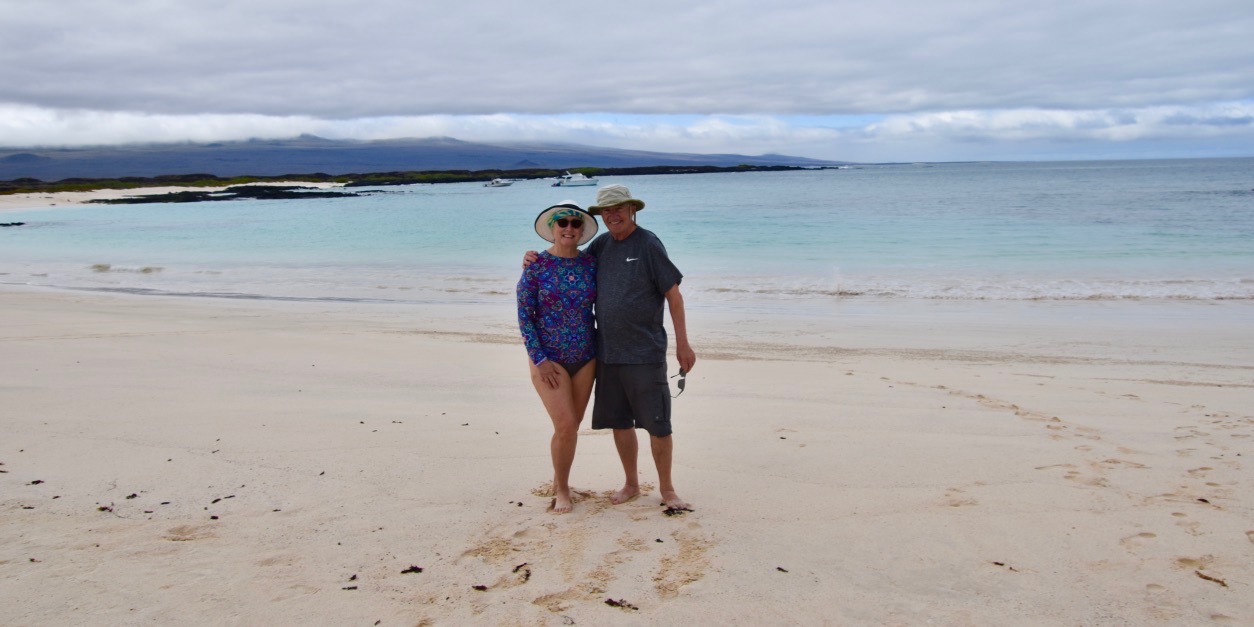
Portions of the beach are littered with tiny holes that I know must be made by crabs and sure enough with minimal patience we start seeing ghost crabs everywhere. These little buggers are infamous for lying in wait for sea turtle hatchlings and dragging them into their burrows for a feast before they ever get a chance to paddle their way to the sea and potential freedom.
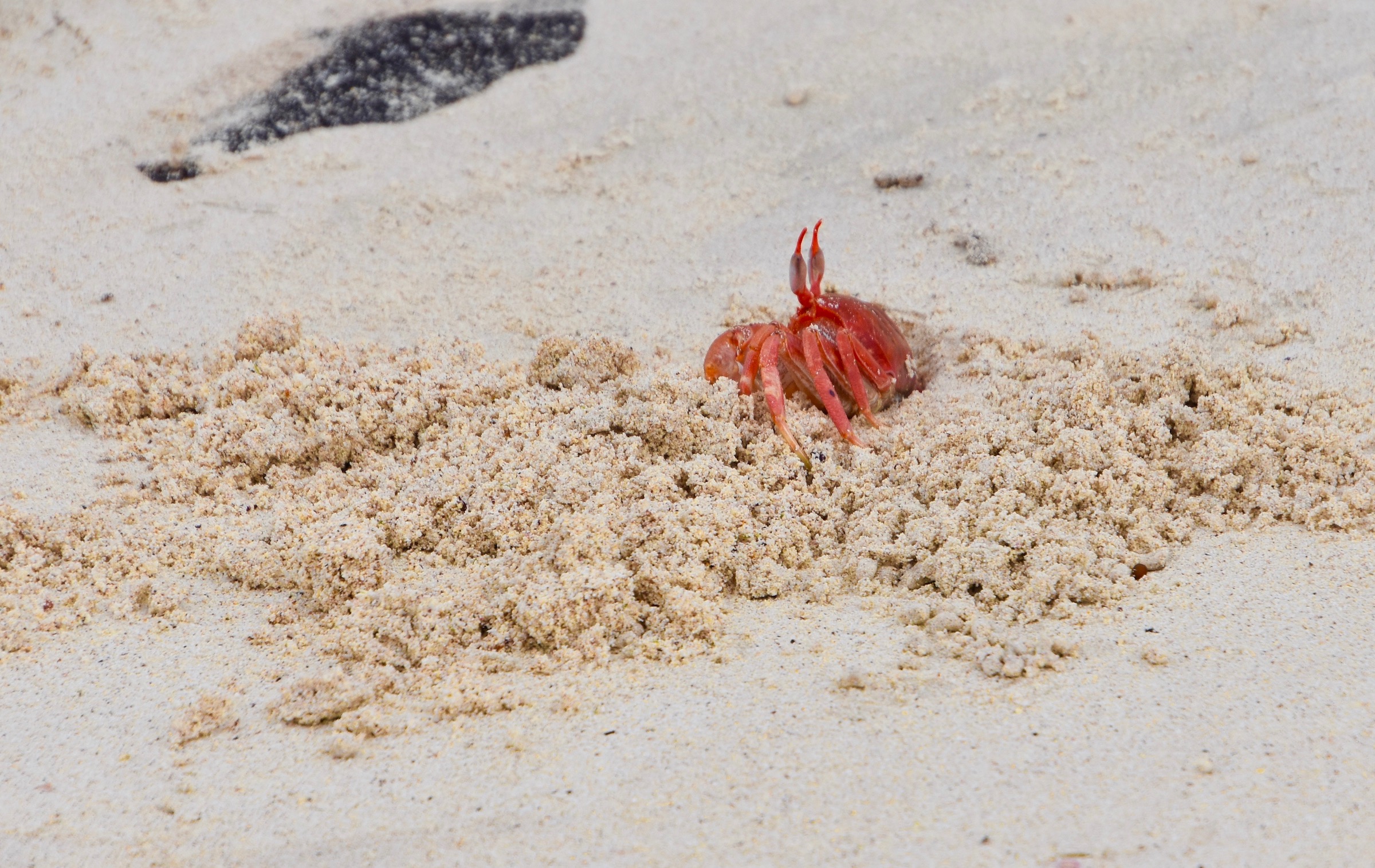
There are also of course sleeping sea lions that are oblivious to our presence as Alison is observing with Kicker Rock in the distance.
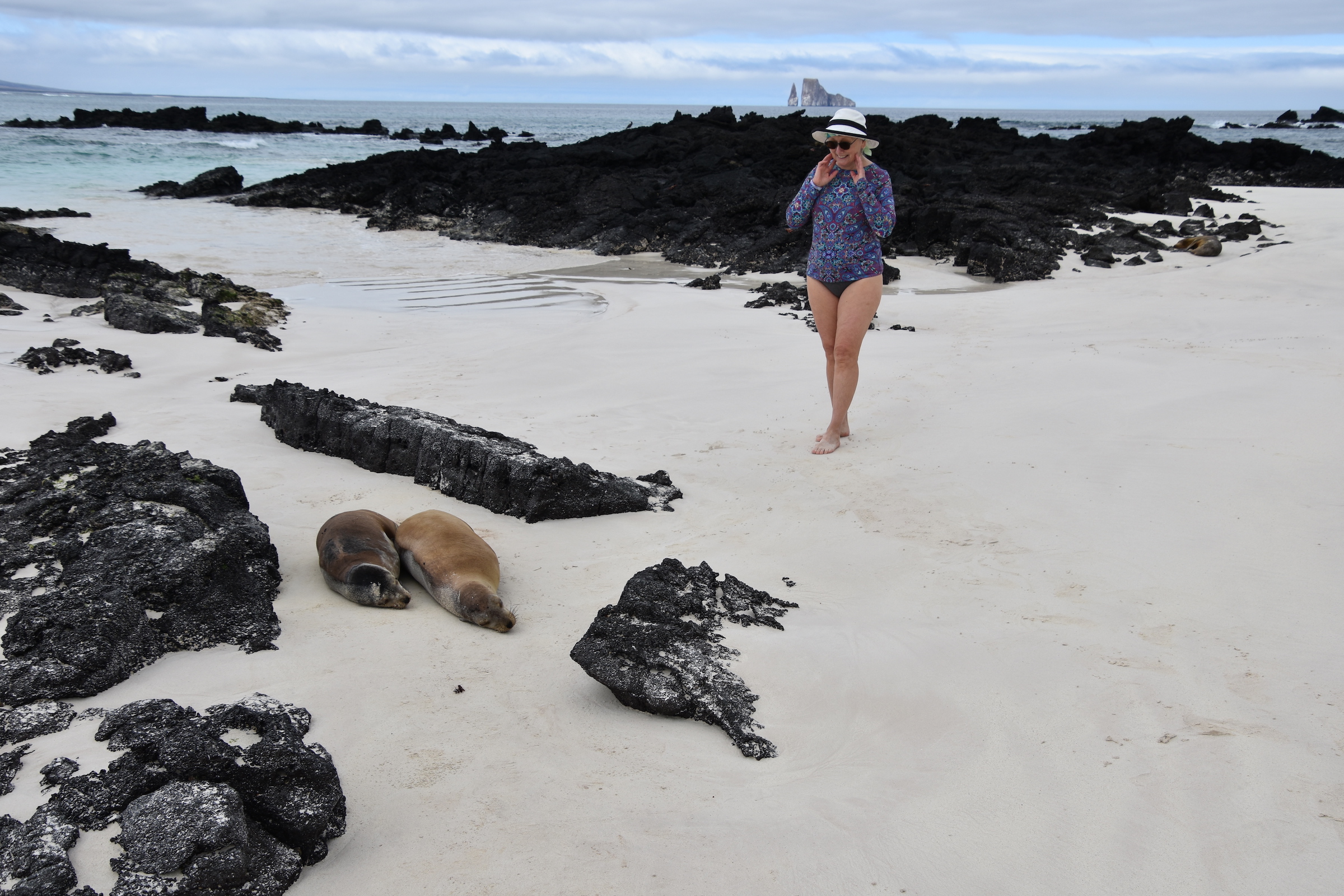
Climbing up the dunes at the back of the beach gives an even better perspective of this wonderful place with only our boat in sight.

Well camouflaged with grayish feathers amid the volcanic rocks are a number of Darwin’s finches which, once they move, we can spot. These drab little birds played the most significant role in the development of the Theory of Evolution of any species that Darwin observed and it’s only appropriate that they bear his name. There are 18 distinct species of them and I believe this is the small ground finch.
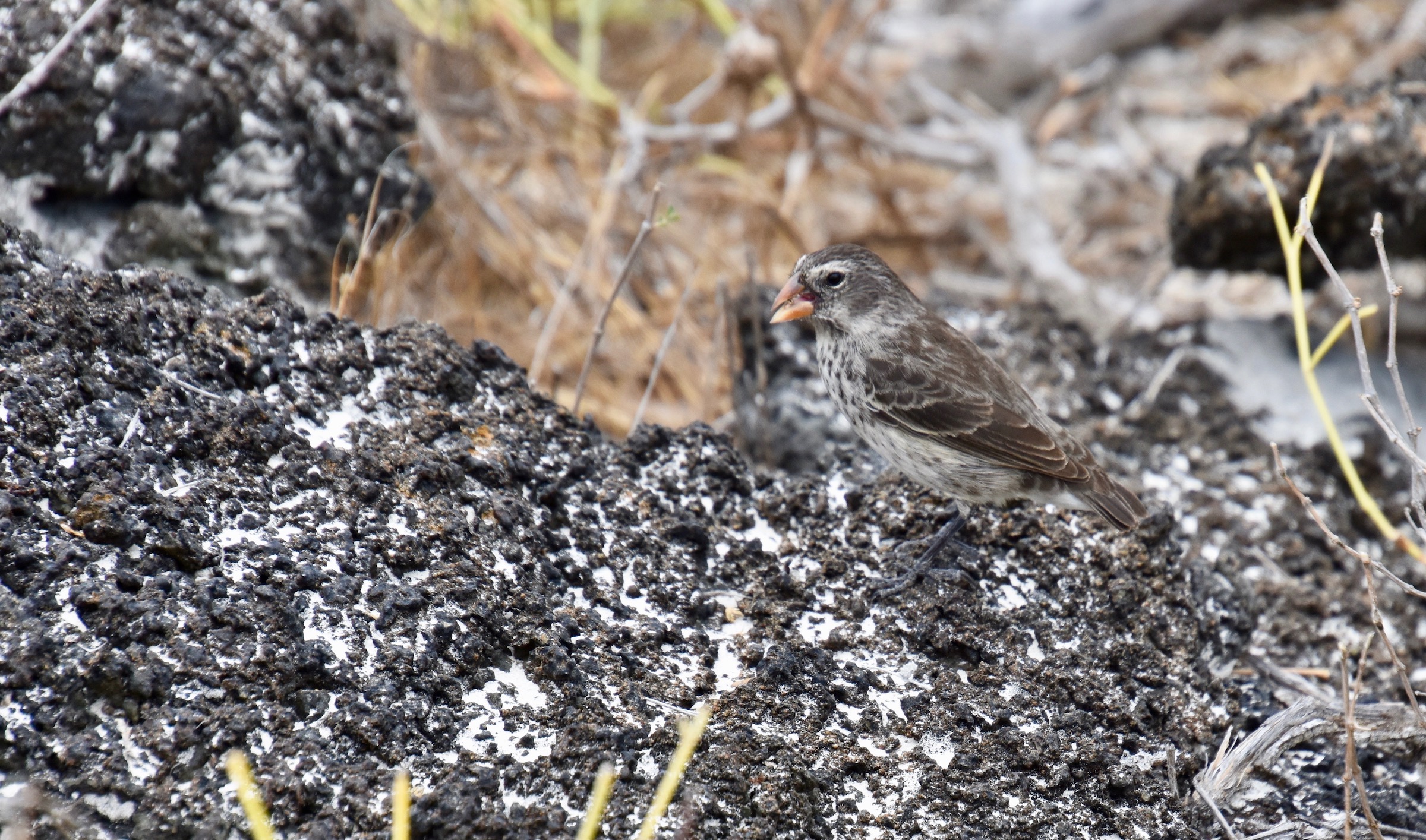
Much easier to spot are the marine iguanas that are now out sunning themselves to get their temperature up after their morning feeding session. This sharp looking fellow is a big male and despite his somewhat ferocious look with those spines sticking out of his back they are perfectly harmless.
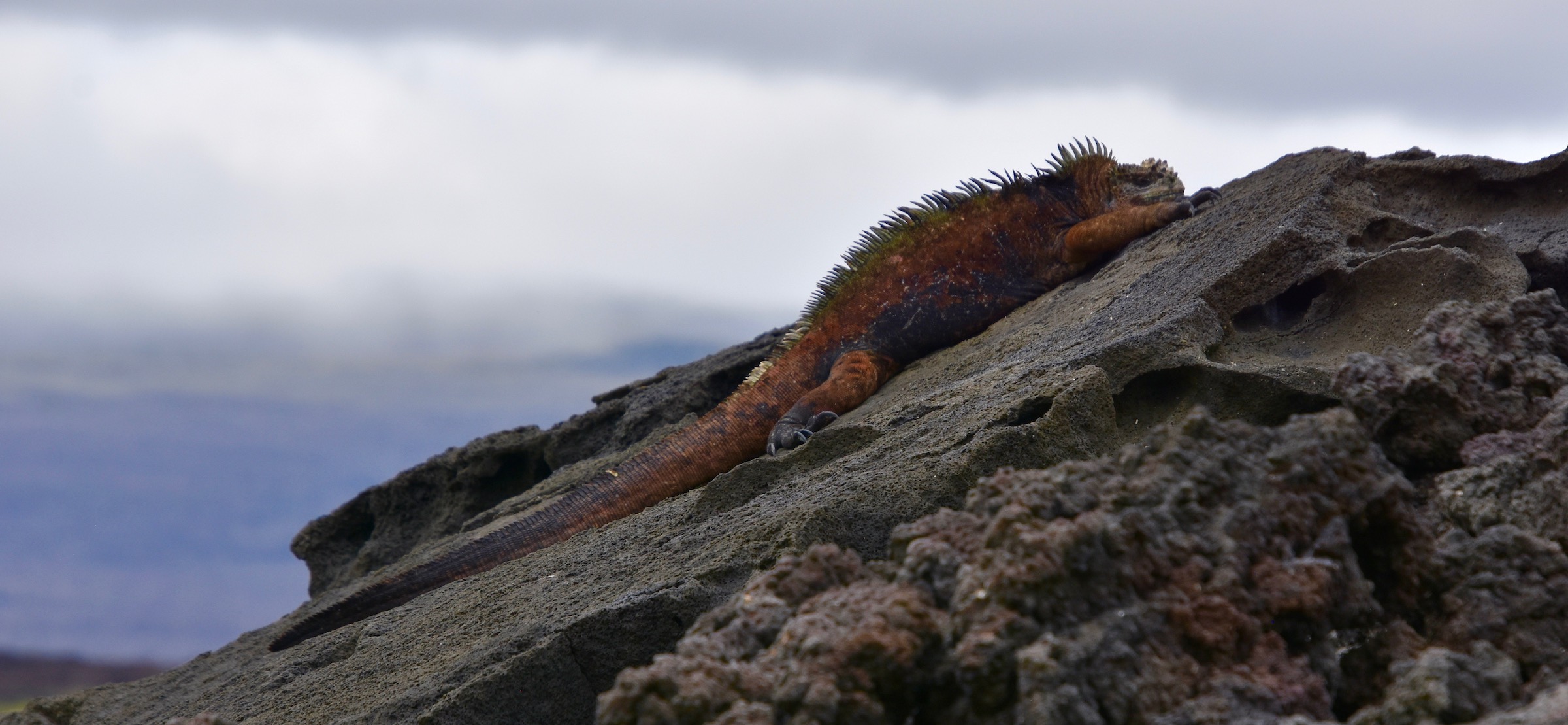
We also spot numerous Galapagos mockingbirds, one of four endemic mockingbird species on the islands, but my photos are a bit too blurry.
Alfredo leads us to a small cove at the foot of Cerro Brujo where there are tidal pools to investigate which we do while Adi and Alfredo become BFFs with Kicker Rock as a witness. Adi, from NYC, was one of the singles on this trip and I don’t think anyone enjoyed themselves more than he did.
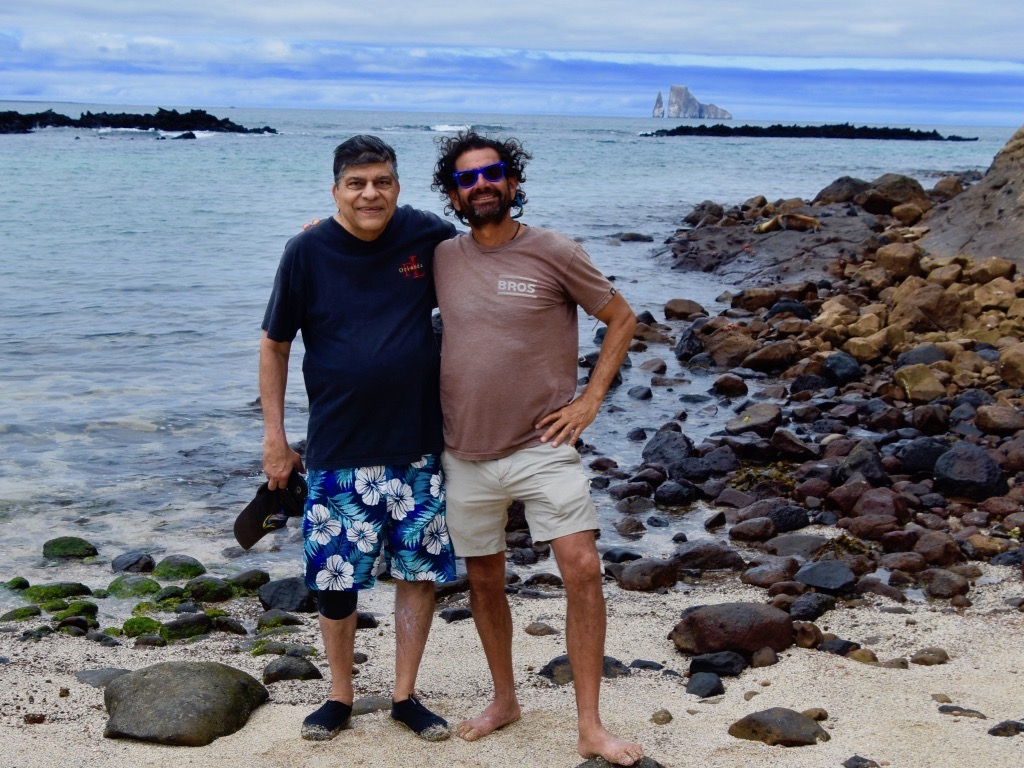
Alfredo said we had time to walk to the far end of the beach and back if we wanted to and how could we not? You’re not going to get opportunities to play Robinson Crusoe like this very often. Heading out we saw lots of lava lizards, another species Darwin studied.
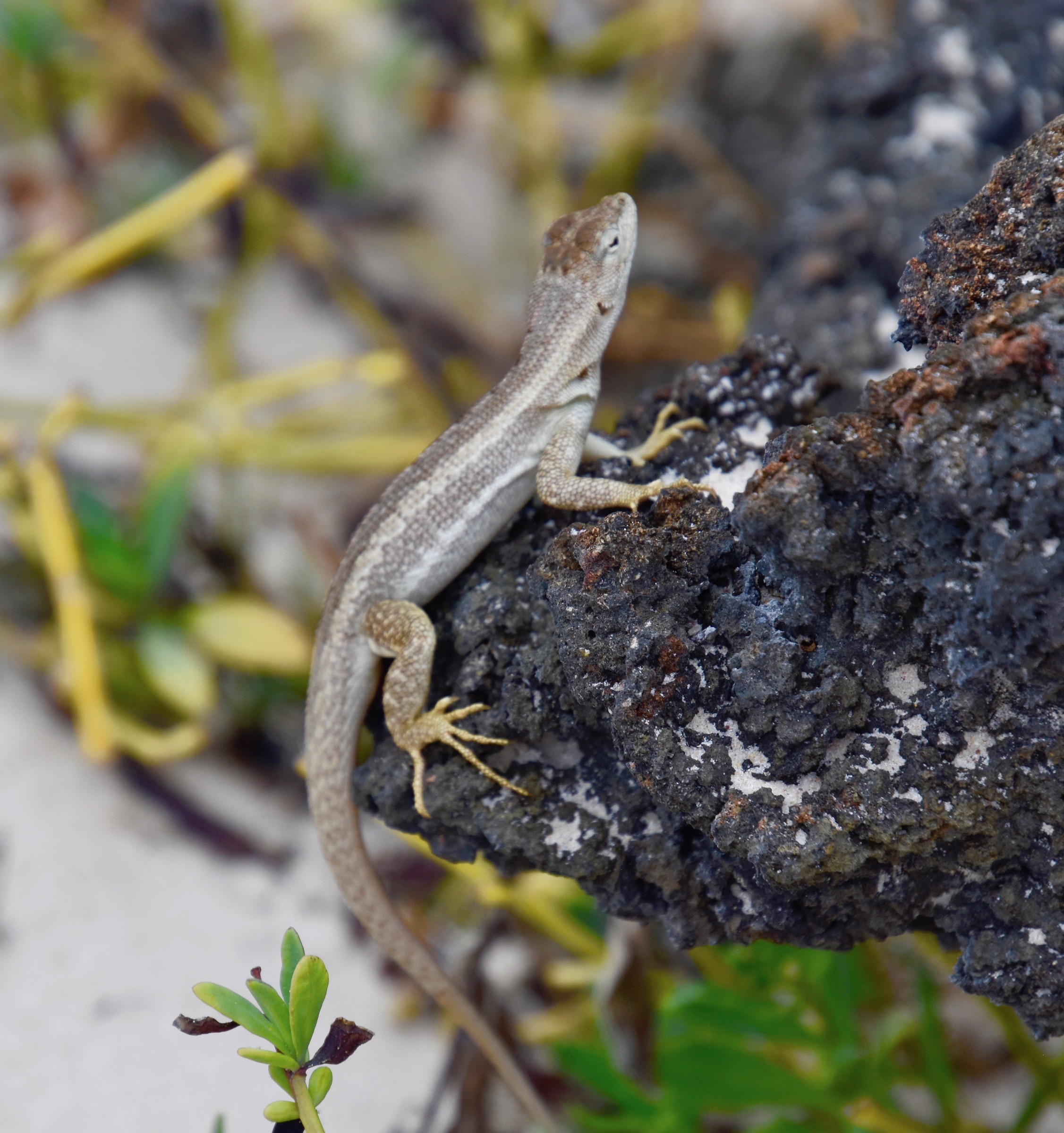
And these tracks indicating that a marine iguana had just passed this way.
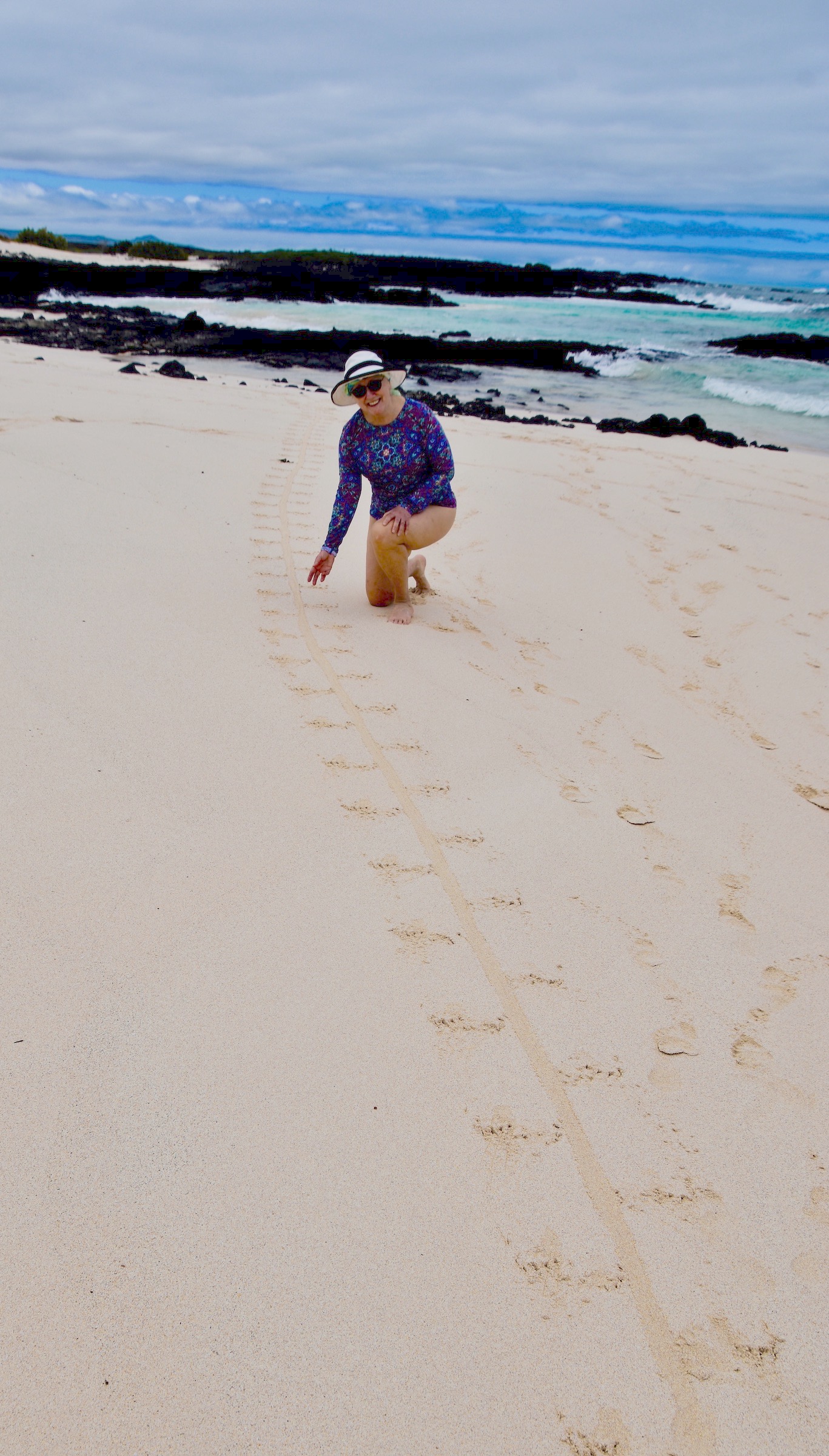
This place was turning out to be a naturalist’s paradise as we racked up species after species. Oystercatchers are not endemic to the Galapagos, but the ones found here only inhabit the archipelago and never get back to the mainland. There are only 400 or so of them and in time they will evolve to become a completely new species from the landward counterparts.
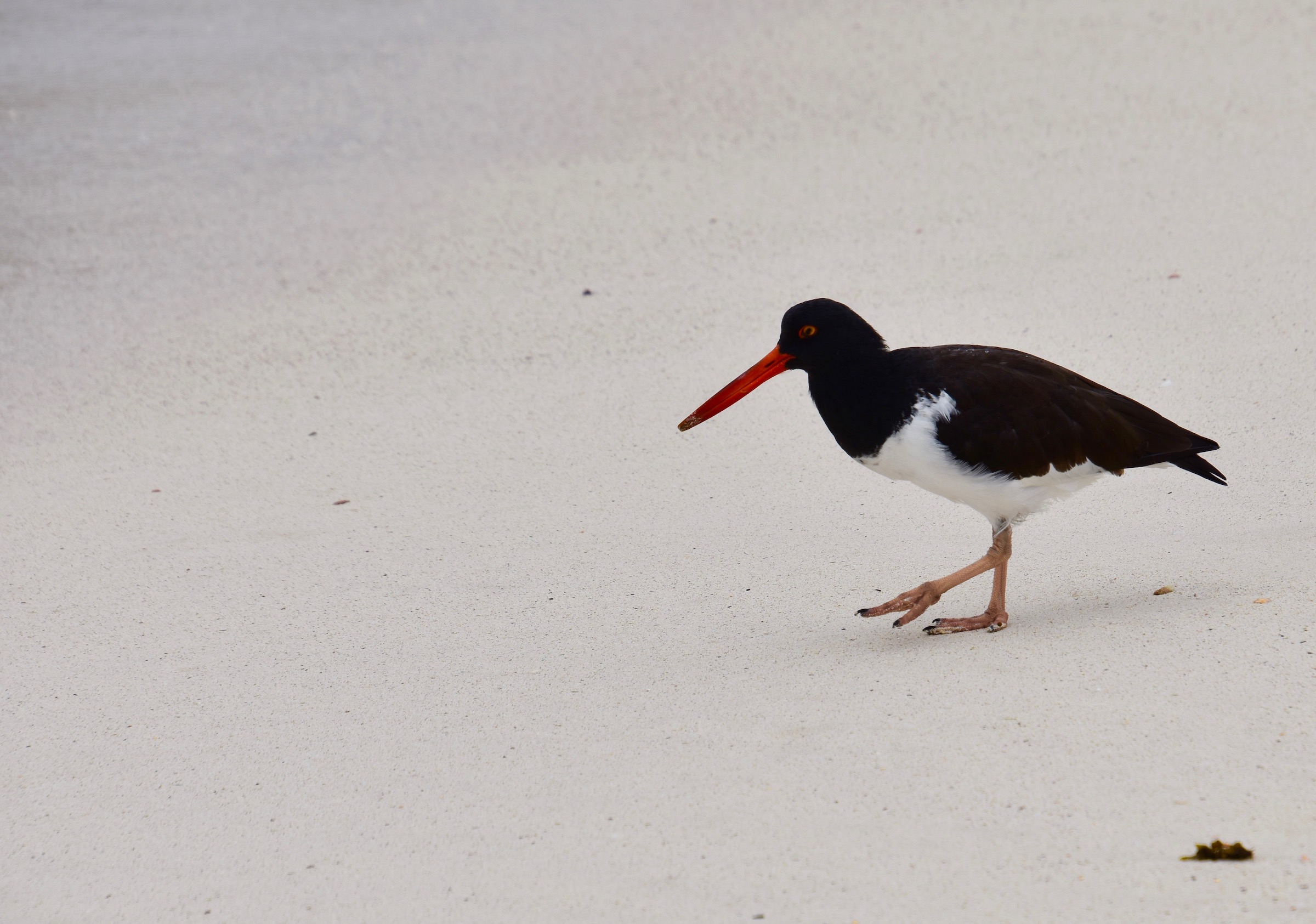
The brown pelican is one of my favourite birds and in the same situation as the oystercatchers. Some already believe they are an endemic species which could not breed with other non-Galapagos brown pelicans, but nobody knows for sure. Once again we are really in the midst of an evolutionary laboratory that can only be experienced by visiting here. I can’t say I’ve ever seen one sitting like this in the middle of a lava flow and was wondering if the species is evolving to prey upon the crabs that are all over the place.
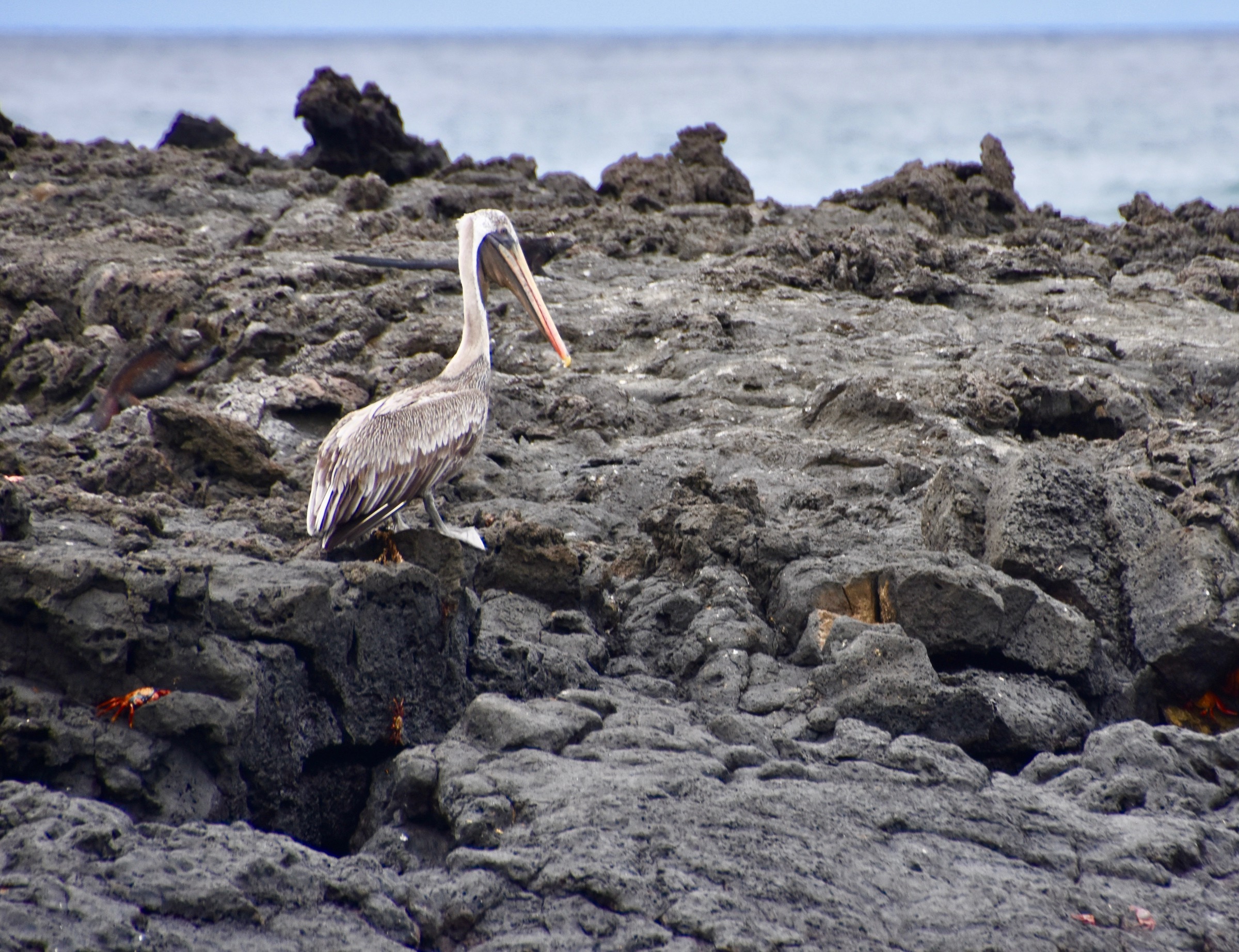
Alas, all good things must come to an end and we trudged back to join the others on the zodiac trip back to the boat. Here is a look at the second group coming back.
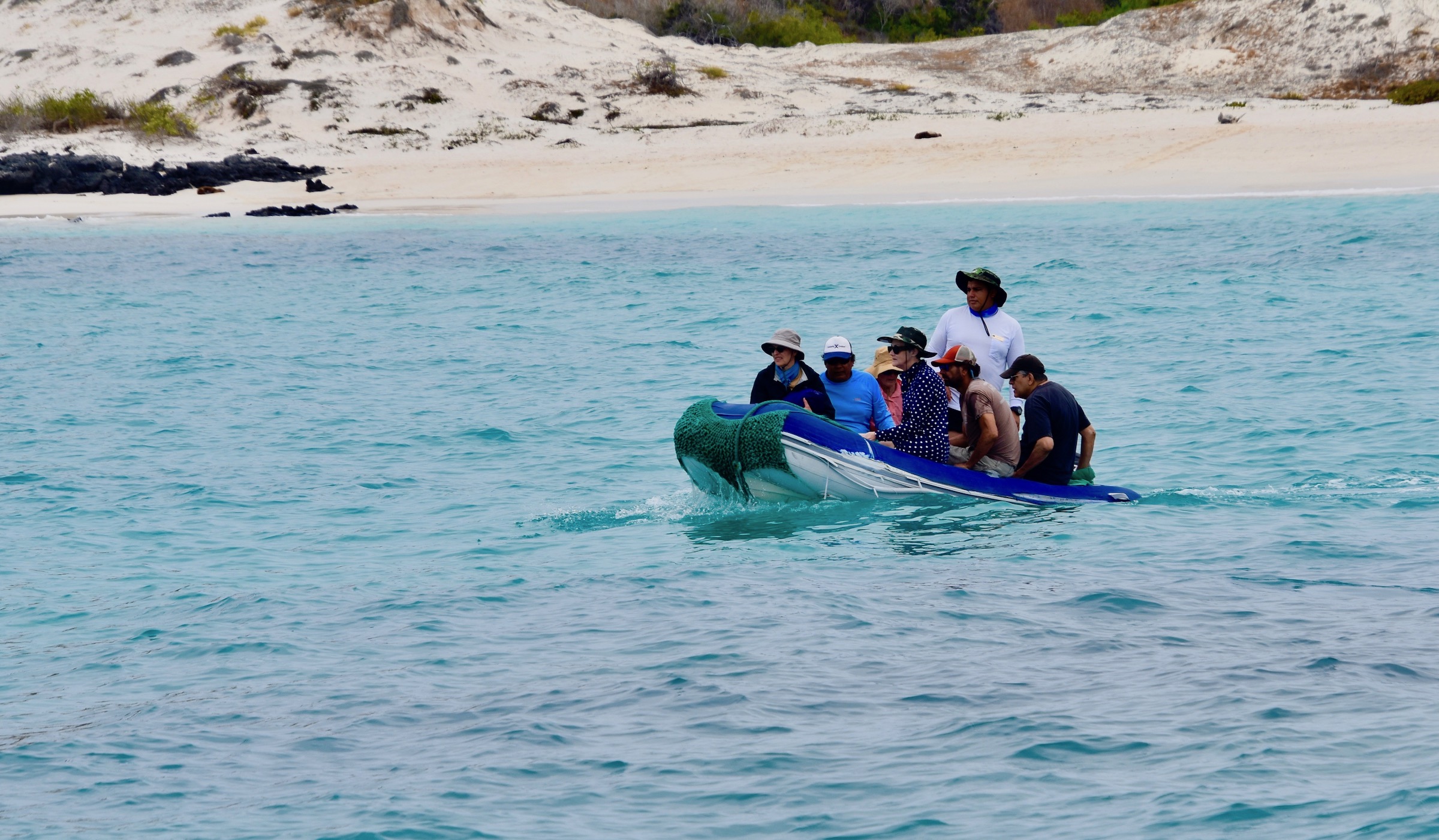
The second part of our boat trip was focused almost entirely on Kicker Rock. We motored around Cerro Brujo and got a look at it through Darwin’s Arch.
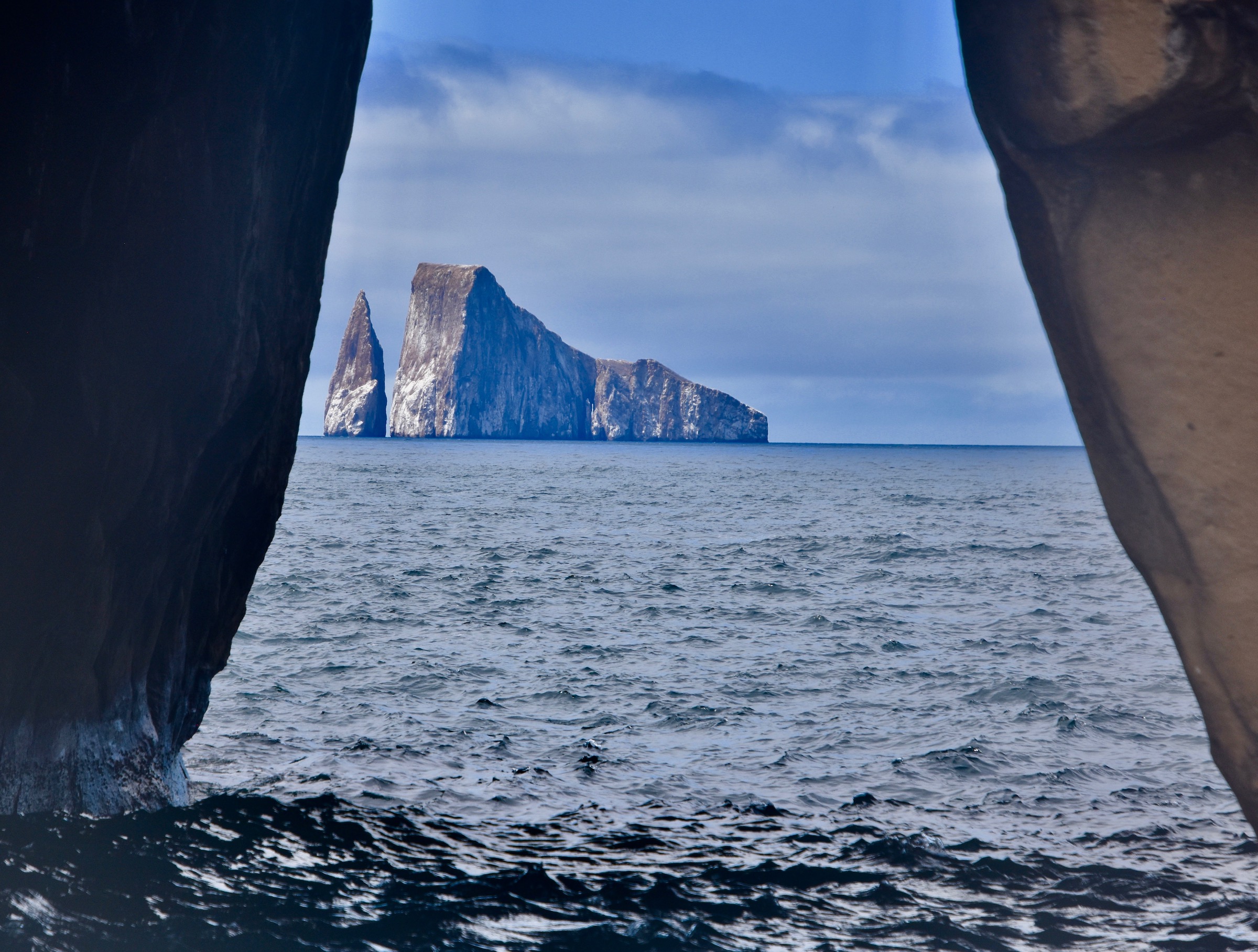
Kicker Rock is a volcanic plug that juts out of the water in such a way that has made it one of the most iconic formations of its type anywhere. Your eye cannot help but be drawn to it from every angle.
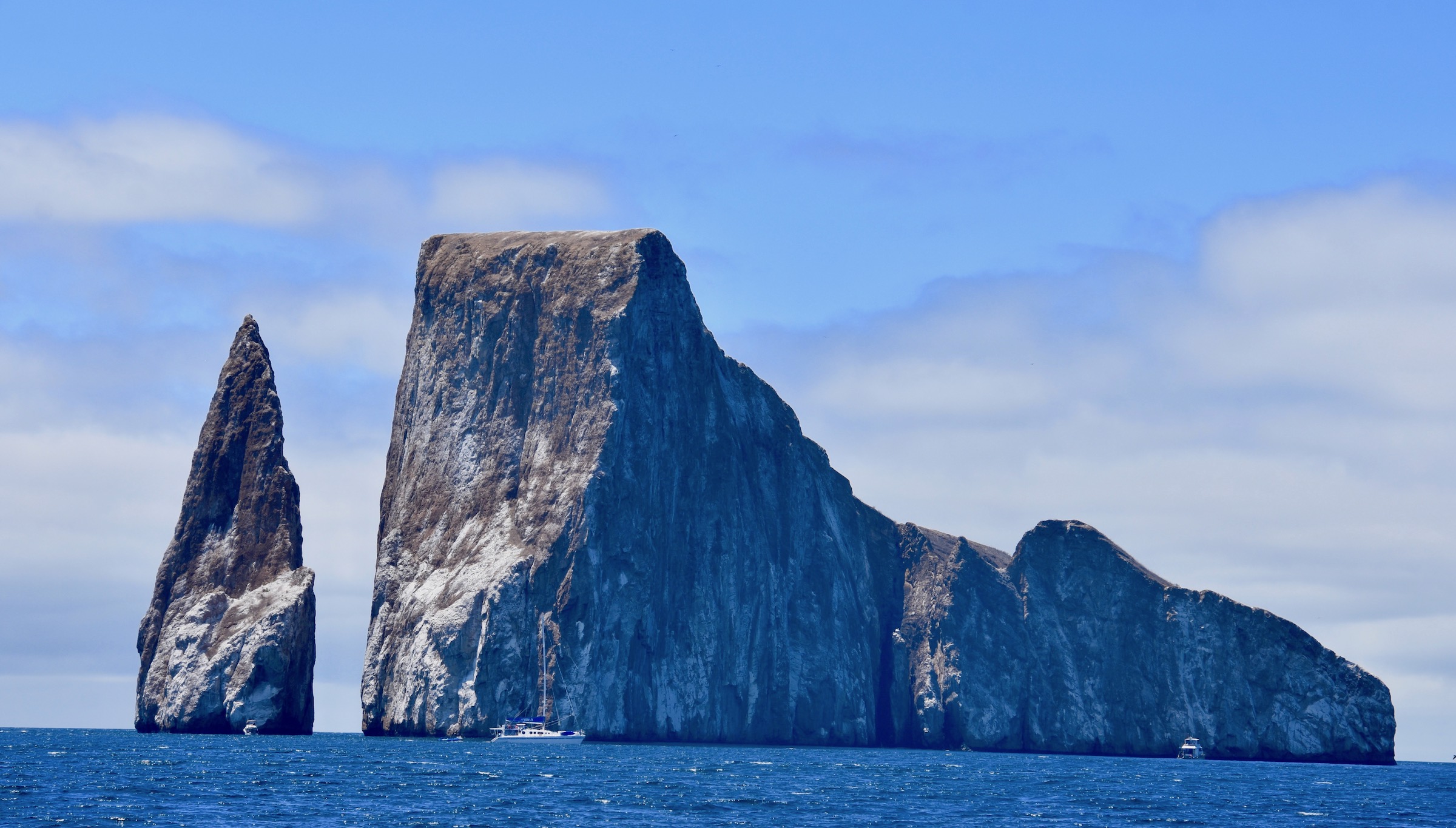
Before anchoring to begin our snorkelling, the boat circles the island and the birders on board get yet another life lister, the Nazca booby which bears a strong resemblance to the Northern gannet that breeds on the very similar shaped rock known as Ile Bonavista in the Gulf of St. Lawrence.
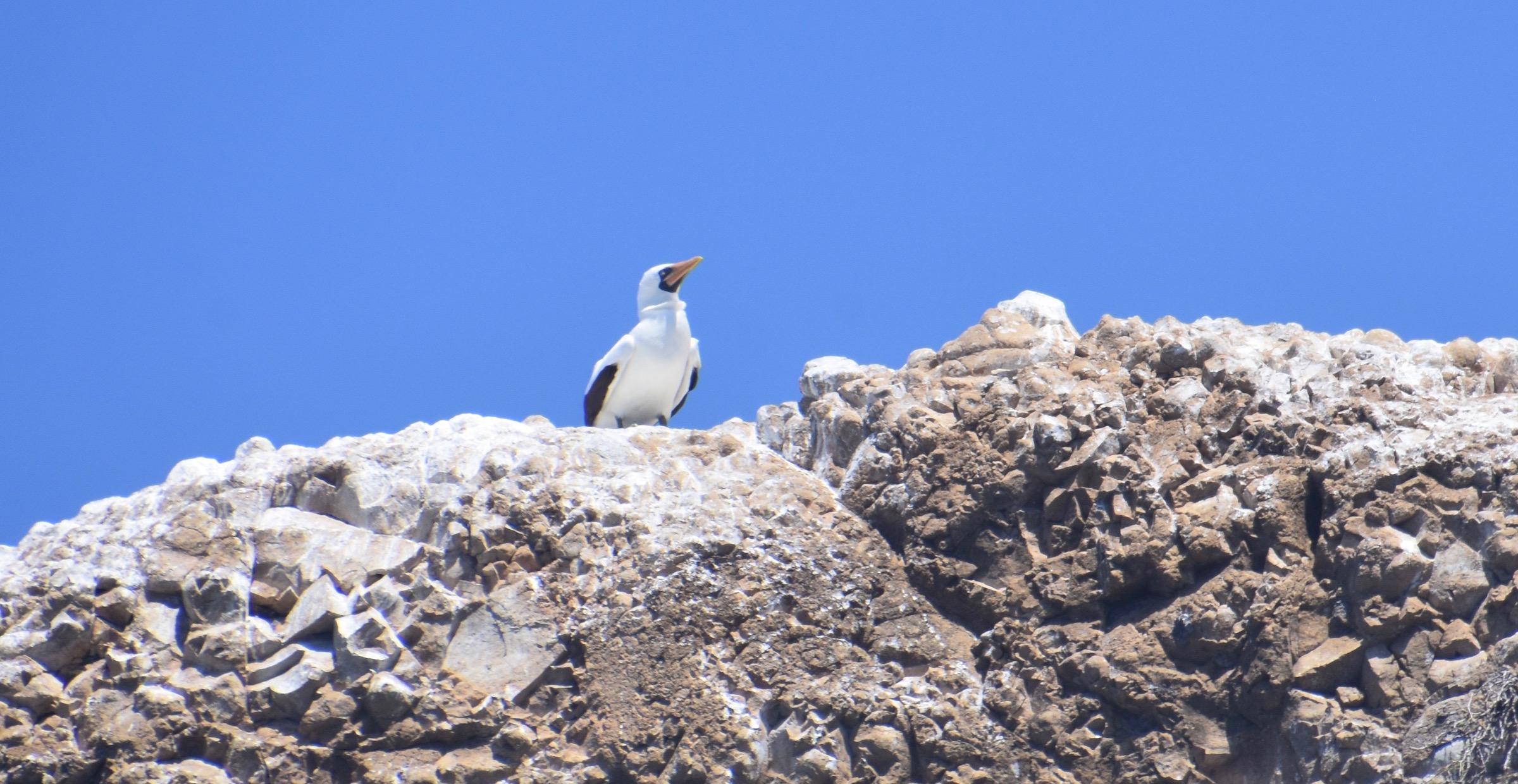
We also get a close up look at the split of Kicker Rock which is very reminiscent of Cape Split in my home province of Nova Scotia. I notice with a bit of trepidation that there is a pretty strong current running through the split.
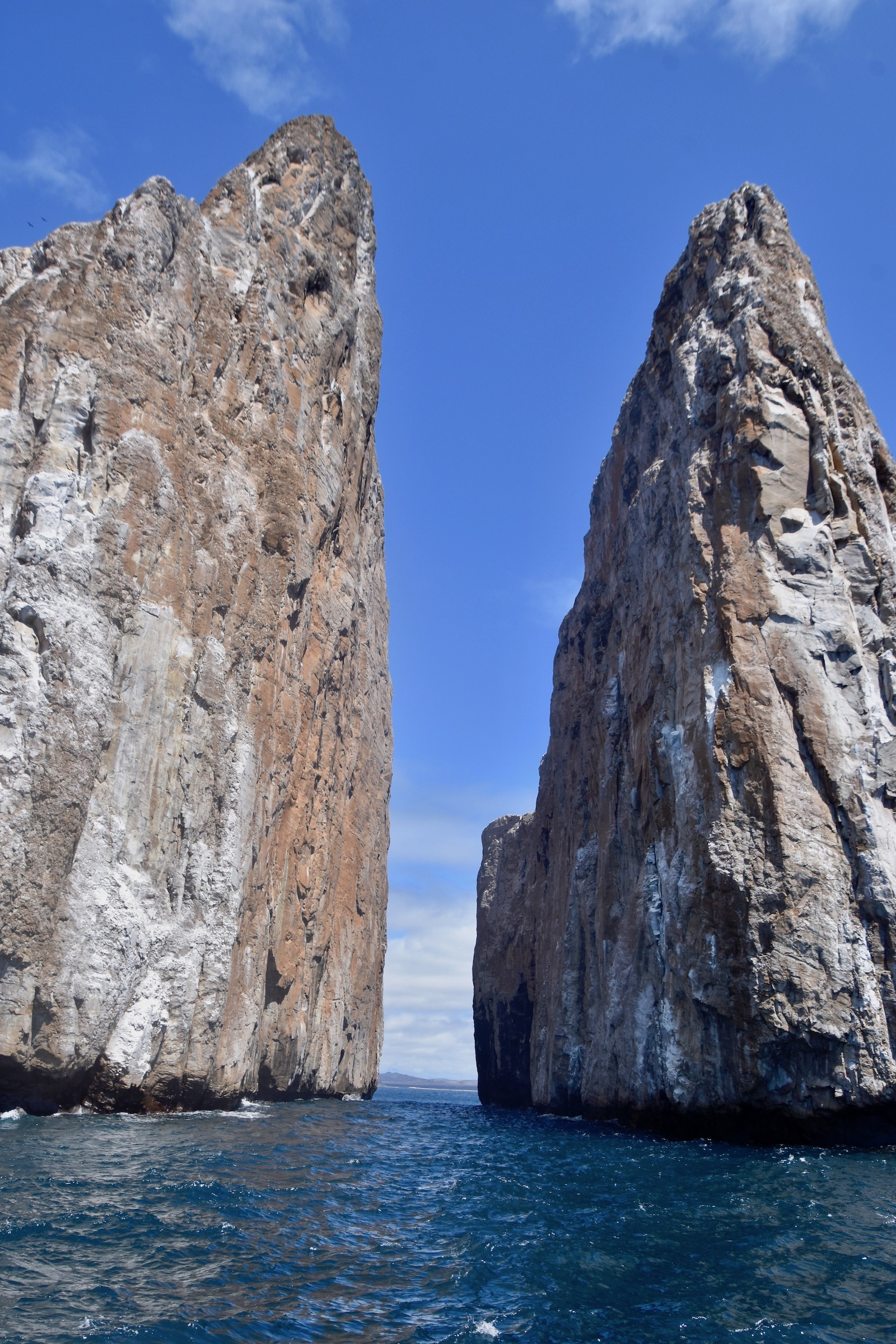
Not far from where this photo was taken the boat stops and we don our wet suits for our first off boat snorkelling session.
Kicker Rock is quite different from most snorkelling in that you observe the fish and other sea life along the edge of a cliff in water that is up to 130 feet deep. In perfect conditions you can see far down and might see some really big items like sharks, manta rays and large predator fish. In less than ideal conditions you’ll see smaller fish closer to the surface and that’s the water conditions we have today as the clarity is probably about 20 feet. Alfredo and a crewman will lead the group each pulling a life ring which you can choose to hold onto or not. I used it occasionally, especially when we crossed the split as the current was quite strong. We all had pfds so there was no danger even if you were not holding on. The boat was also close by.
I wish I could say it was a great snorkelling experience, but while interesting, the number of fish and species was a disappointment and that was due to the lack of water clarity and a bit to the current. However, that doesn’t mean that the next visit won’t be sensational. There are lots of videos on YouTube showing great snorkelling at Kicker Rock and anyone interested in this trip should look them up. I’m letting the cat out of the bag here, but I don’t want to leave the impression that the snorkelling on this trip was a bust. There are two absolutely world class outings coming up that more than made up for Kicker Rock.
After getting back on board we had a nice lunch awaiting us along with some canelazo which could be referred to as ‘instant warm up’ for those brave enough to try it. We returned to port after lunch at Kicker Rock. That night Alfredo took us to a local home where the hostess showed how to prepare one of my all time favourite dishes – ceviche, which I could eat 365 days a year. Here Alfredo is explaining the proper ingredients with Kicker Rock beside him. Looking at it from this perspective it does indeed look like a kicking boot.
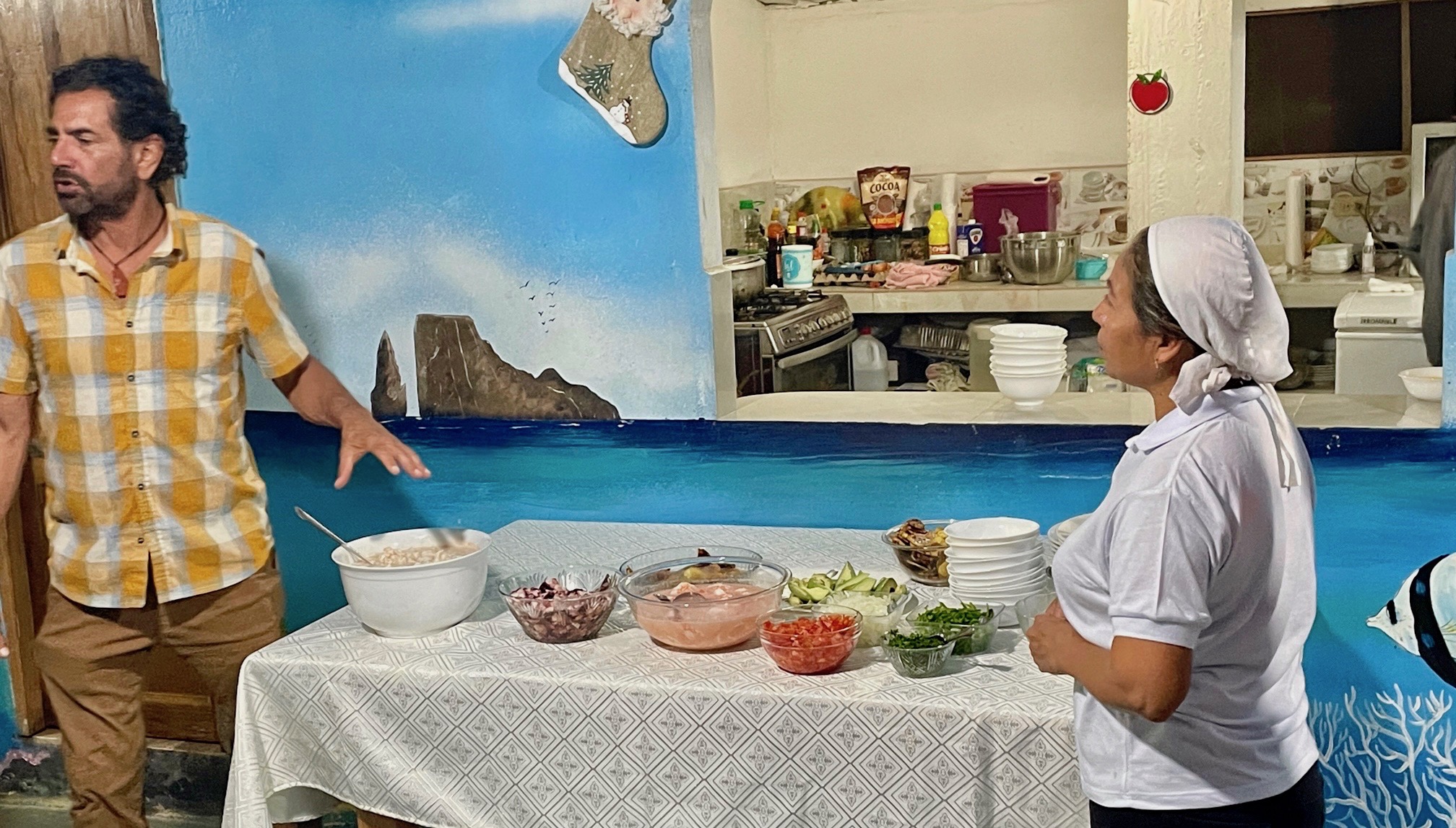
The final product, which was heavy on Ecuadorean shrimp, was phenomenal and provided a perfect end to a near perfect day.
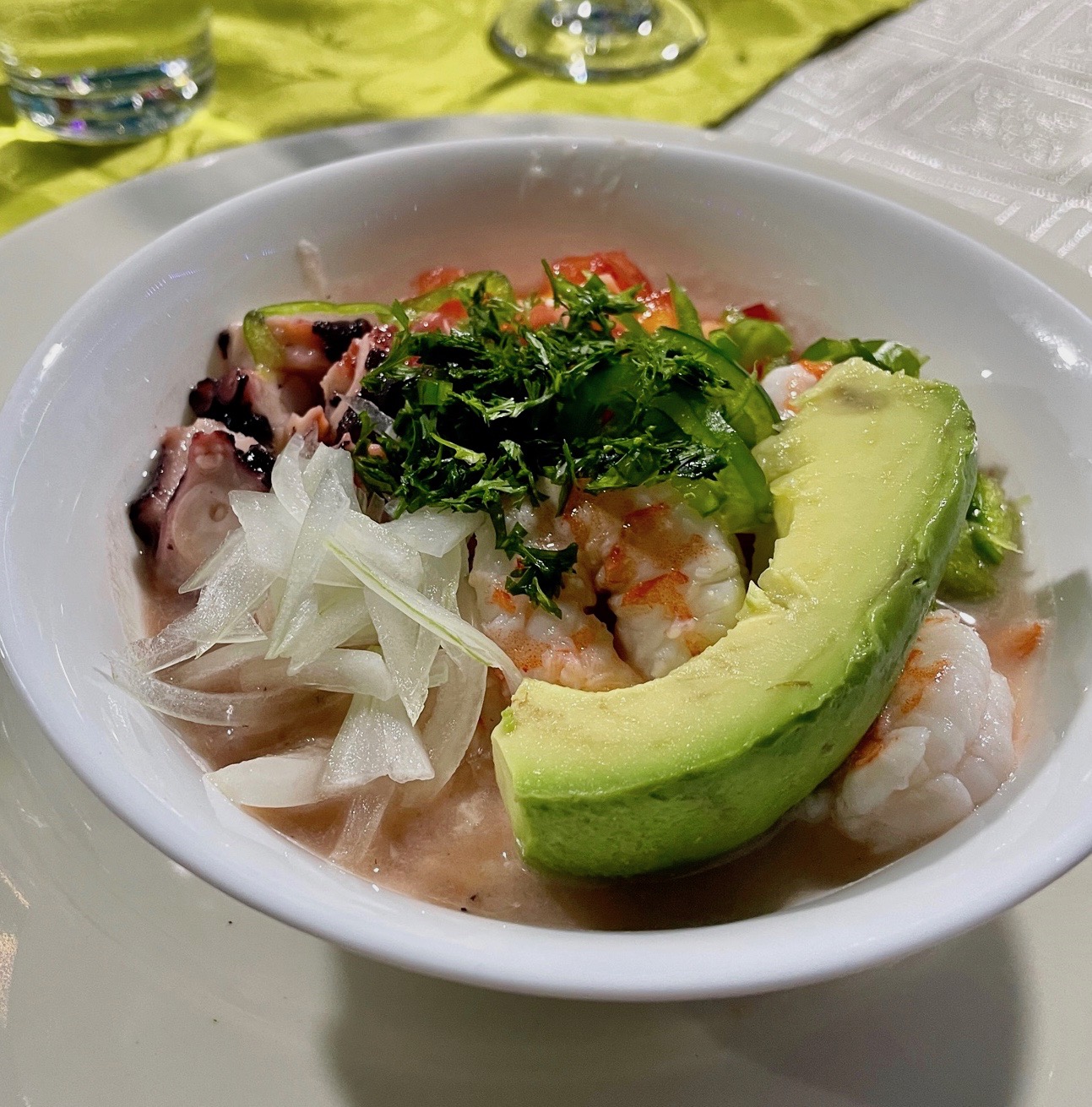
Tomorrow we head for Isabela, the largest of the Galapagos where we will spend three days. I hope you join us.

